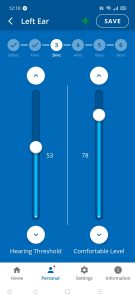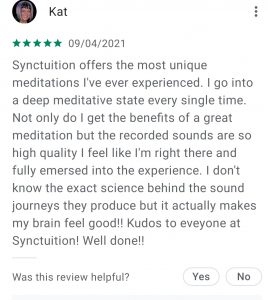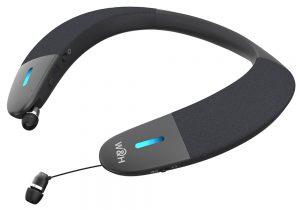A decent stereo pair of loudspeakers can set you back hundreds of pounds. Or, if you’re a serious hi-fi aficionado, (and rich) tens of thousands of pounds. This is one reason why, back in those old bed-sitter student days of the ’60s, I developed a preference for headphones. You could get decent quality sound from them for an affordable price.
These days we have a couple of respectable loudspeaker sound systems here at Tested Technology Towers. But much of the time I still lean towards headphones to avoid annoying the family. Unless you use special digital signal processing between the amplifier output and the headphones, you’re going to get a very different sort of soundscape from what loudspeakers deliver. Whether you think this is a compromise or just a different sort of experience is up to you.
There’s a technology mid-way between loudspeakers and headphones that has always intrigued me. There are various names for it but the most descriptive is “nearfield listening”. Instead of using large speakers to deliver convincing bass and to fill the room so the music can benefit (or not) from the local acoustics, very much smaller speakers using a lot less energy, are positioned close to the ears. No room acoustics, but the stereo separation you get will be closer to the sound engineer’s intention than headphones would deliver.
And the bass? Small, low-power speakers aren’t famous for delivering much bass.
In fact, they may be rendering the bass faithfully, but at low energy that quickly dissipates on the way to your ears. Nearfield hearing puts the speakers a lot closer to your ears and the bass gets delivered.
You can test this with your smartphone. Those tiny speakers are doing an amazing job but they sound tinny from ten feet away. Next time you’re in a hotel room and want to relax with a Mendelssohn piano concerto but haven’t packed your Bluetooth speaker, try lying down with the phone on your chest, immediately under your chin. Bass energy falls away with the square of the distance. With only six inches between you and the smartphone, the bass should be coming through very much louder and clearer.
This nearfield listening approach is the technology behind the BeHear Proxy. You might be surprised at how well it works.
 THE BEHEAR PROXY IS A lightweight electronic collar that positions a pair of small loudspeakers over each collarbone so that they fire directly up into the ears. While worn they’re completely unobtrusive and during the tests I found it was very easy to forget I had them on.
THE BEHEAR PROXY IS A lightweight electronic collar that positions a pair of small loudspeakers over each collarbone so that they fire directly up into the ears. While worn they’re completely unobtrusive and during the tests I found it was very easy to forget I had them on.
Once switched on and Bluetooth-connected to your phone, television set or whatever, the Proxy is able to provide an expansive, full-range stereo soundscape that you might easily mistake for surround sound coming from hidden hi-fi speakers.
This effect is highly addictive, to the extent that I found I’d worn and used the Proxy for well over a month without beginning to do the reviewer’s job of getting to understand the technology and testing all its facets. I hope BeHear sees this as a compliment to the product, even if it’s an inditement of me and my workflow.
This turns out to be a great way of getting the full dynamics of an action movie or an interactive video game without annoying your neighbours or even your family in the next room. However, others in the same room with you will hear the regular, somewhat tinny sound you’d expect from small speakers. Understandably, this can be annoying and might even lead to divorce.
The BeHear Proxy has this covered. In the photo above you’ll see a pair of small earbuds peeping out from under the bottom of each wing of the Proxy. Their cables are on spring-loaded ratcheted reels that allow them to be pulled out to reach your ears. With the speakers switched off, you can now use the Proxy as a conventional pair of earbuds in private listening mode.
Tuning the Proxy
Regular readers will know that I’m somewhat deaf, or “hearing impaired” to use the modern, supposedly less offensive term. For several years now I’ve been wearing hearing aids of various kinds that boost the upper frequencies.
The BeHear Proxy is designed for people like me. It’s based on a generic Bluetooth hardware product called the Torus from the Chinese manufacturer Avantree. BeHear has added its own ingenious sound tuning software to offer the same features that we covered in our review of the BeHear Access earbuds last year.
 With the earbuds activated you can now use the BeHear app (Android or iOS) to work through a short tuning session, not unlike the hearing assessment process an audiologist takes you through when fitting hearing aids.
With the earbuds activated you can now use the BeHear app (Android or iOS) to work through a short tuning session, not unlike the hearing assessment process an audiologist takes you through when fitting hearing aids.
There are six frequency settings, between 500Hz and 8kHz. The app offers a pair of volume sliders for each frequency: you adjust the left-hand slider to the point where the sound just becomes audible and the right-hand slider to the most comfortable volume for that frequency.
You run this six-part procedure twice; once for each ear. The whole process shouldn’t take more than three minutes, although you might need to go through it a couple of times to get familiar with it.
 Once completed, the app presents you with something very like the chart an audiologist uses for your first hearing aid fitting. It lacks some refinements: today the profession might prefer to work with more than just six frequency bands and best practice will include “real ear measurement” to assess exactly how sound waves behave inside your own uniquely shaped ear canals. But the level of precision of this BeHear test seems well-matched to the capabilities of the hardware. With the advantage that you can carry it out yourself and subsequently alter the tuning to taste.
Once completed, the app presents you with something very like the chart an audiologist uses for your first hearing aid fitting. It lacks some refinements: today the profession might prefer to work with more than just six frequency bands and best practice will include “real ear measurement” to assess exactly how sound waves behave inside your own uniquely shaped ear canals. But the level of precision of this BeHear test seems well-matched to the capabilities of the hardware. With the advantage that you can carry it out yourself and subsequently alter the tuning to taste.
Key Features of the BeHear PROXY
- Comfortable, wireless neck speaker (keeps ears free)
- Crisp TV dialogue (with no delay!) and rich stereo sound just inches from the ears
- Personalized amplification of live conversations
- Loud and clear wireless mobile calls
- Extractable earphones for privacy, or in consideration of others
- Suitable for use with (and without) hearing aids
Earbuds mode has similar features to the BeHear Access, including the optional ability to amplify ambient sound. Unlike the Access, it has only a single built-in microphone, which makes it less able to handle speech in noisy surroundings. These earbuds, listening through the microphone, may make it easier to hear movie dialogue, although a direct connection using Bluetooth would probably be a better option in this scenario.
Meditation
I wasn’t at first going to include this section. Following a request for audio material to test the BeHear Proxy, an outfit called Synctuition very kindly donated a lifetime’s subscription to their Android app. But when I explored the app, “Synctuition – MindSpa Meditation, Sleep and Calm” from the Google Play Store. I was immensely discouraged by what struck me as California-style pseudo-psychological New Age whimsical motivational mumbo-jumbo.
A “MindSpa”, presumably, is a spa for the mind in the same way that a FootSpa is a spa for the foot. Yes, it’s very easy to make fun of this stuff. But it seems that many of Synctuition’s subscribers have drawn great comfort and spiritual benefit from it.

I can’t sneer at heartfelt tributes like Kat’s, so I put my own bias to one side and plunged in.
The first thing to say is that the meditational soundscapes Synctuition has put together—a series of “journeys” through 100 25-minute melanges of seascapes, gongs, bird sounds, weather and what-have-you—wash over you from the BeHear Proxy like a warm, aromatic bath.
“An amazing physical experience,” says Claire Wymer in her Google Play Store review. “Wow, what a journey”. And I’d have to agree with her.
The Proxy is excellent for administering this stuff, intimate but entirely unobtrusive. It’s just you and the thunder and the floating notes of the flute and the rain on the roof.
The main thing that had been putting me off was the voice-over, a plaintive American incantation telling you that you’re becoming more relaxed with every breath you take and that opening the door to your imagination will release the magic genie from the bottle and make the impossible your new reality.
Not my kind of thing at all. But the app designers evidently saw me coming and have thoughtfully provided a “Skip the Intro” button. I had assumed this languorous language lingered through the whole of each journey but it turns out to be just a get-you-started three minutes before the pure soundscape opens up around you.
Perversely, now I knew I could shut off the narrative I decided to let it run in all ten of the “journeys” I’ve so far been through (“undertaken”? “Set forth on”?). I’m told (by the voice) that my intuition is now flourishing.
The full Synctuition course costs about £90 for a lifetime subscription. If it works for you as it evidently does for Kat and Claire it may be worth a punt. You can also experience this soundscape stuff, without the inspirational narrative, with an app like Chris Newby’s free to download Lightning Bug. What particularly appeals to me about this is the way you can put your own soundscape together, melding white noise, seaside waves, bamboo chimes and the cry of the bald eagle to your own taste. Lightning Bug comes with two starter packs of readymade sounds. Other packs, normally a cost option, are free of charge at the time of writing and can be downloaded through the app.
Limitations and Downsides
There’s not a lot to say here. The tuning-for-hearing-loss feature only applies to the use of earbuds—in loudspeaker mode the output is linear across the frequencies and you have control only over the total volume.
The earbuds come with a choice of silicone tips to fit your ears and can be used easily with or without your hearing aids. Creating a comfortable fit was no problem but I did find that the sound from the earbuds while using Bluetoo th, even with my phone turned up to full volume, tended to be rather quiet. It’s possible to cheat this during your initial tuning session by over-stating the volume at which you can hear each of the frequencies and then choosing a “comfortable volume” that’s on the louder side.
th, even with my phone turned up to full volume, tended to be rather quiet. It’s possible to cheat this during your initial tuning session by over-stating the volume at which you can hear each of the frequencies and then choosing a “comfortable volume” that’s on the louder side.
The various switches will take some time to master. In use, they’ll be out of your line of sight, so you’ll have to learn to locate them by touch. There’s a familiar Volume Up, Volume Down with a central Stop/Start arrangement on the outside of the right-hand wing. This will be naturally operated by your right thumb.
In this position, the right index finger falls naturally onto the On/Off switch on the inside edge of the right wing. However, this is a spring-loaded slider that requires a rather awkward sideways movement of the finger while the right thumb holds the wing firm. The switch has to be held in this unnatural position for a few seconds before it responds.
The design thinking here is evidently that a push-button might too easily turn the device on by accident but there might be better ways to protect against this. A further complication is that immediately below this slider switch is the silicone cover for the microUSB charging port. For easy opening, this cover has an obtruding nub that your index finger could easily mistake for the On/Off slider.
A relatively trivial point (or perhaps not) is that the black material that covers the up-facing loudspeakers resting on your collarbones will highlight even the tiniest flakes of dandruff.
Conclusion
Many of us are hearing-impaired without even realising it. In my own case, the discovery took me at least five years or perhaps longer. You can read here the story of how my complaints that the rest of the family were constantly mumbling lead to my first NHS audio appointment
If I’d had the BeHear Proxy then, the hearing assessment test built into the Android app would have alerted me a lot earlier.

BeHear’s chief audiologist, Suhail Habib Allah, is also an electrical engineer. “My dream was to… develop a device that empowers the user with more control over their hearing while providing high-fidelity sound.”
The Proxy, with the self-administered audio test built into the corresponding smartphone app, is no substitute for properly audiologist-adjusted hearing aids. But if you are hearing-impaired, the device might make a good deal of difference to your enjoyment of music and home entertainment in general, with or without hearing aids.
Here in the UK we’re are lucky enough to have National Health Service support. In other parts of the world, being fitted with modern hearing aids can cost thousands of pounds. In this context, the price for the BeHear Proxy of €189, including shipping, while not an out-and-out bargain, is certainly not unreasonable.
For those with 100 per cent hearing—sadly, a rapidly diminishing number in the Western world—the BeHear Proxy is still a really useful Bluetooth audio accessory. If you’re sure you don’t (or won’t ever) need the BeHear refinements, the original Avantree Torus would be a cost-saving choice.
Chris Bidmead
